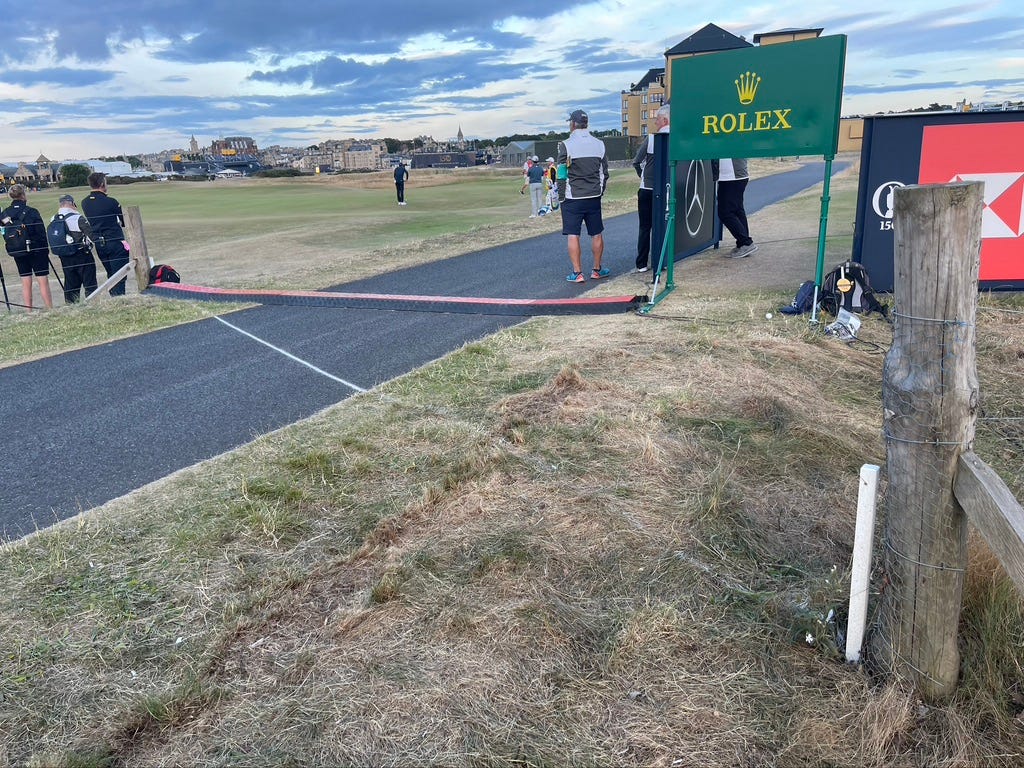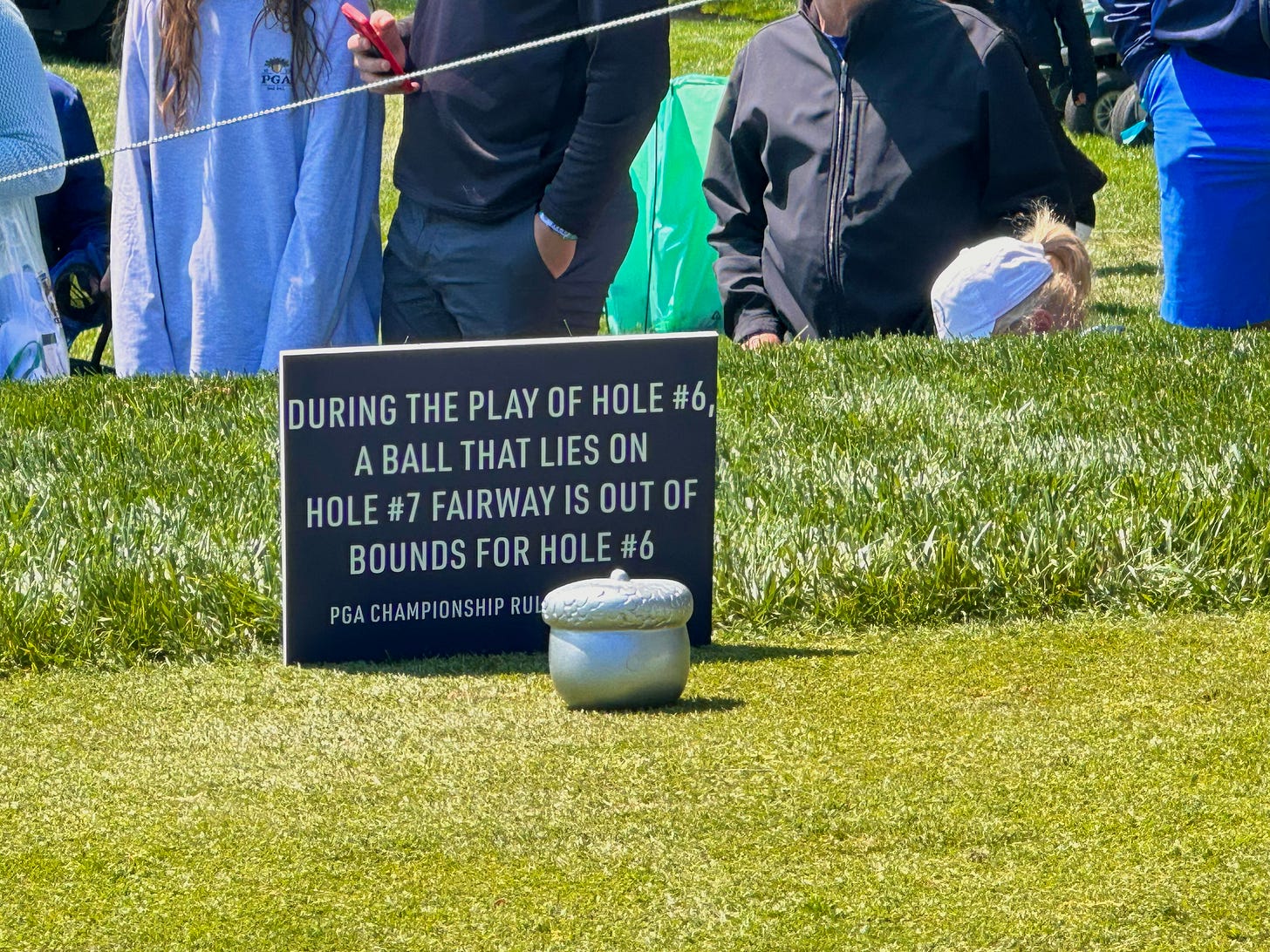The Internal Debate, Part 2
Why boundaries inside a golf course have long been seen as less than ideal and how they may impact this year's Open Championship at Royal Portrush.

Part 1 looked at the historical significance of Royal Portrush boundary lines and how they impacted past Open Championships. Today, why the concept is so loathed without an obvious boundary barrier, and how some key holes will play at this year’s Open.
Complicated, this is not.
The offensiveness of internal boundaries comes down the cruelty of finding your ball on the wrong side of a white line and the absurd logic of not getting another swing at the ball.
It’s right there!
I can play it!
There is no fence, wall, gas main, or earthquake fault! So I can’t play it just because someone with a paint gun, white stakes, and a hammer wants to deprive me of golf’s most fundamental, charming, and under-threat driving rules tenet—play the ball as it lies.
Captain John Rattray and the Burgesses would be horrified!
Maybe that’s not quite how the internal dialogue plays out. But golfers are instilled with a genetic revulsion to a manmade intervention or the appearance of it. Just look at how many bizarre holes are accepted when features are the handiwork of nature. But a human being sketching out a fake hazard? It’s offensive. Same with internal boundaries. If there is an ancient wall or obvious property line, fine. Some paint and stakes? No one likes it.
The notion of a stroke-and-distance penalty is antithetical to the wild early days at Leith Links when they were playing shots off of steps, streets, horses’ backs, paths, picnic blankets, and God knows what else.
The tradition of finding your ball and playing it was fostered in St Andrews, where even a road known as The Links running along the home hole was not delineated as out-of-bounds until more recent times. Speaking of today’s juiced game, I can safely say that Old Tom and friends never teed off from out of bounds, as Open contestants now do at the second, 14th, and 17th holes. But Old Tom also never deadlifted 355 pounds like Jon Rahm can.
As the sport moved from linksland to different environments and the ball flew farther, white stakes were used to cut off shortcuts and protect the innocent from design flaws. In modern championship golf, it remains something discouraged by the USGA and reluctantly adopted by the R&A.
The PGA of America delineates the 7th fairway at Oak Hill as out-of-bounds to prevent players on the par-5 par-4 sixth from trying to take a shortcut down the seventh fairway. Given modern driving distances and the chance to play alternative routes, a similar idea should be considered at Cypress Point for the Walker Cup. But the modern-day USGA doesn’t like to do such things. (The old guard would just bring in a tree overnight.)
The other most famous internal boundary at an Open course can be found at Royal Liverpool where a small land form defines the boundary on the Open routing’s third and 18th holes. The grass-covered hillock gives some sense of a boundary, even if an area is cut down to mark the boundary and the turf on the other side is cut down. (For member play, this is the warm up area.)
While faux boundaries instill fear and give the holes a memorable feature, they also seem to be retained to protect the integrity of designs in a juiced equipment era. It’s always about the ball going too far!
Disdain for non-property line boundaries has always been a source of consternation for rules officials. Over fifty years ago, Geoffrey Cousins addressed what’s so loathsome about internal OB in his glorious little book, Golfers At Law (1959). The book considers the spirit of the rules and Cousins did not see internal boundaries vibing with the ideals of the sport.
“In the early days of enclosed courses the only out-of-bounds areas were those outside the boundaries of the course. But in recent years there has been a tendency, particularly by golf clubs having easy or ill-designed courses, to make up for deficiencies in severity or design by artifical out-of-bounds areas within the confines of the course. This is done by the cutting of shallow ditches between fairways, using rows of saplings as boundaries, or even by marking white lines as arbitrary boundaries. Sometimes this occurs even on first-class courses. On the Royal Liverpool links at Hoylake, for example, a player is out of bounds to the left of a cutting alongside the third fairway, and to the left of the seventh green. At the latter point we have the absurd situation that a ball played from the seventh teeing-ground could finish on the eighth teeing-ground and yet, according to the out-of-bounds rule and the definition of boundaries by the local committee, be ‘off the course.’”
The USGA’s Executive Director, Joe Dey wrote the introduction to Cousins’ book and praised the London Star writer’s rules perspectives.
A love for the things which golf represents must have been the motive which prompted Mr. Geoffrey Cousins to write Golfers at Law. It must have required unusual research. It certainly required unusual background in the history of the game and especially knowledge of the Rules of Golf. Like every other golfer, Mr. Cousins does not agree with every jot and tittle of the law, but any interpolation of his views is so constructive that it is never intrusive. He makes a splendid plea for continued simplification of the Rules and for making them real to the average golfer. Mr. Cousins is completely qualified to do all this.
Joe could write, too.





